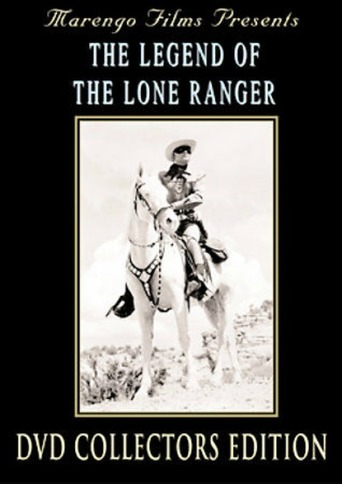classicsoncall
For old and new fans alike of The Lone Ranger TV series, this is the three part origin story start to finish without the standard opening and closing sequences of the individual episodes to interrupt the continuity of the story. For devotees of the Ranger, this is the grand daddy of all Western sagas, telling as it does how Texas Ranger John Reid survived the ambush by the Butch Cavendish Gang, and how he was nursed back to health by an Indian friend from his childhood. Tonto (Jay Silverheels) declares his companion a 'trusty scout', and names him Kemo-sabe. I've read various interpretations of the origin of the term Kemo-sabe, but I'm satisfied with Tonto's explanation. Reading too much into it just detracts from the story, just like the English translation of 'tonto' from Spanish, which I won't mention, because it's just better not to know if you can help it.I thought it quite clever how the origin story created the mystique of the Lone Ranger, like the sixth grave that created the illusion that all the Rangers died in the box canyon ambush. You never see the face of the man who becomes the Lone Ranger, as it's always turned away or obscured to hide his real identity. Even the origin of Silver is handled brilliantly; the voice of the story's narrator describing the wild stallion's sterling qualities. I got just the biggest kick out of that explanation.For it's time, The Lone Ranger was a prolific TV Western with two hundred and twenty one episodes spanning eight years on the air from 1949 to 1957. Quite notably, most of the individual shows never quite matched up in quality to the first three episodes telling the origin story, but that was a simpler time and special effects in Westerns was virtually unheard of. But the show captured the imagination of this viewer as a young boy, as the Lone Ranger became one of my personal heroes along with such luminaries as Tarzan and Superman.
bkoganbing
This compilation film edited from the three part half hour television show that gives us the story of the origins of The Lone Ranger was something I vividly remember as a child. Looking back now and seeing it again it looks kind of silly, except maybe to the eyes of a six year old.A wounded mixed race renegade named Collins played by George J. Lewis comes into Texas Ranger Headquarters with a bullet wound and information about the whereabouts of Butch Cavendish one of the most notorious outlaws of the Old West. Captain Reid played by Tris Coffin goes in pursuit of the gang and one of the Ranger company is his younger brother John.But it's a trap, the murderous Cavendish gang led by Glenn Strange has it in mind to get the Rangers into a box canyon and shoot them down. News of a massacre of law enforcement officials would allegedly send terror into their hearts and they'd know better than to pursue the Cavendish gang.Collins does the dirty betrayal, but he's shot down like the rest. Only one badly wounded ranger survives and he's nursed by an Indian named Tonto. But instead of a natural bent for vengeance, the surviving ranger who was the younger Reid brother decides on a quest to bring law and order to the west by apprehending criminals wherever he goes. And the appropriate name for this crusader, The Lone Ranger.Of course first things first and the rest of the film deals with the apprehension of Cavendish and his gang. I remember a later episode of the series had the Lone Ranger and Tonto capturing Glenn Strange again after he busts out of prison. But that's later on.Clayton Moore and Jay Silverheels set the standard for The Lone Ranger and Tonto, most people can't recall anyone else ever playing them. And we all well remember how Moore until the day he died literally lived the part by always appearing masked in public. Only Bela Lugosi as Dracula ever carried a single role so much over into his private life.The film is as badly edited as some serial compilations are and the plot does get a bit silly at times. Still it's The Lone Ranger, probably the greatest fictional western hero ever.
NewEnglandPat
This three-episode television classic was filmed in 1949 and introduced Clayton Moore and Jay Silverheels as the Lone Ranger and Tonto. This seminal film details the Masked Man's origins as a Texas Ranger who was ambushed with five fellow rangers by outlaw Butch Cavendish, the Ranger's recovery with Tonto's help, why he conceals his identity with a mask, how he finds Silver, and their round-up and arrest of the Cavendish gang. Moore and Silverheels were perfect as the two leads in this series and portrayed the characters as no one else could have. They were supported by some of the old-school, venerable character actors of the day such as Glenn Strange, George Lewis, Tris Coffin, George Chesboro, and Walter Sande. The crisp black and white photography stands up well with time and the Lone Ranger "mood music" is a superb, nostalgic accompaniment to the program. Each of the three episodes is wonderfully narrated by way of introduction, and the narration is also used introduce key plot situations.
Norman Cook
This is a compilation of 3 episodes of the long-running TV series starring Clayton Moore. It chronicles the origin of The Lone Ranger, and how he met Tonto and Silver, while avenging the death of his brother. A fairly straightforward good guys vs. bad guys story, it nonetheless evokes a strong emotional appeal to the imagination, showing why The Lone Ranger continues to be popular.


